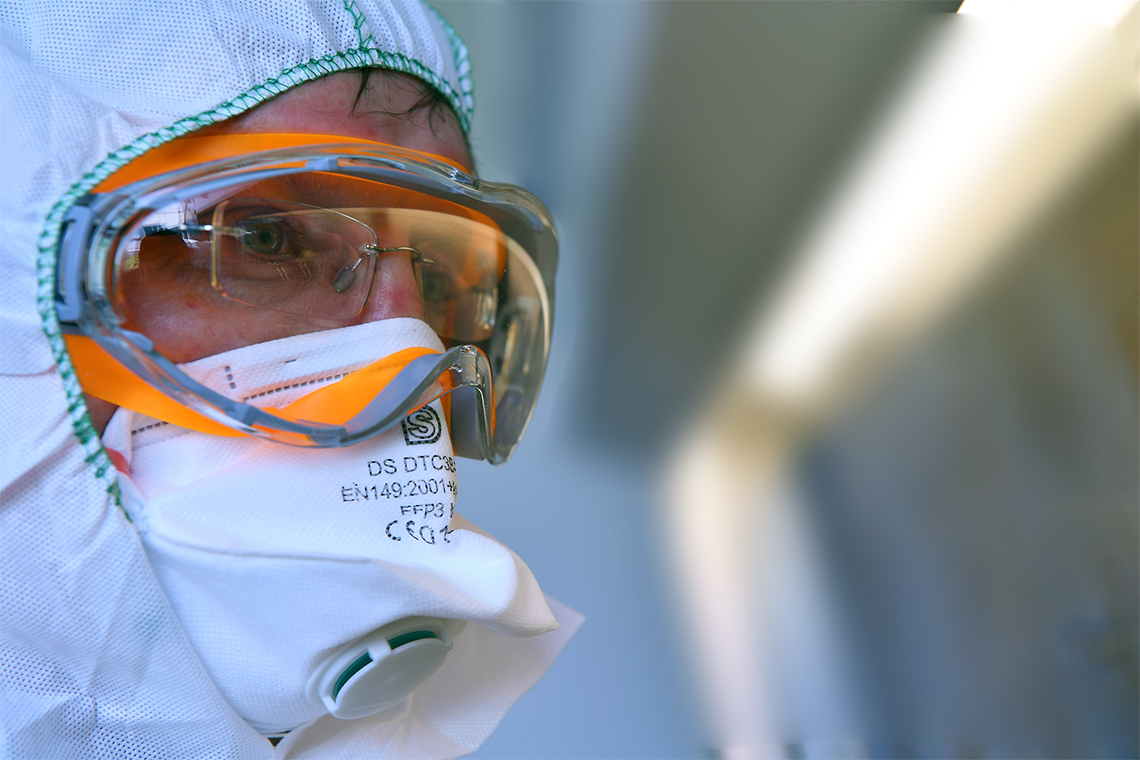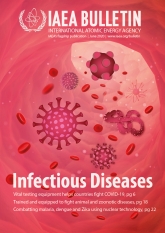
If you would like to learn more about the IAEA’s work, sign up for our weekly updates containing our most important news, multimedia and more.
Overcoming the Unknowns of COVID-19
Nicole Jawerth

“We don’t know” has been uttered by countless doctors, scientists and policymakers during the global COVID-19 pandemic. Caused by a previously unknown coronavirus, COVID-19 has taken the world by storm and presented new questions and challenges that health professionals have been trying to answer and overcome, many of them with support from the IAEA.
“Every day our understanding evolves as new symptoms and complications continue to appear,” said May Abdel-Wahab, Director of the IAEA’s Division of Human Health. “The rapid evolution of the pandemic has resulted in radiology, nuclear medicine and radiotherapy centres around the world being quickly confronted with spreading infections, dramatically increasing patient admissions, overloading clinics, and staff and equipment shortages. Urgent guidance has been needed to address changes at every level.”
During the IAEA webinar, we had a chance to learn directly from leading experts and other health professionals who we may otherwise not have had direct access to.
When the global pandemic began in early 2020, the IAEA immediately recognized the need for guidance and information related to COVID-19 and how to continue essential radiation medicine services, such as nuclear medicine, radiology and radiotherapy, as well as radiation protection and the production of radioisotopes, during the pandemic and the unique conditions it presents.
“As COVID-19 is a new disease and knowledge was limited, there has been a lot of uncertainty around the pandemic,” Abdel-Wahab said. “Routine medical practices needed to be urgently modified in order to triage patients before various procedures and to limit the spread of infections among patients and health care workers, but there was limited information on how to work in this kind of pandemic environment. Some of the practice changes we now see may continue to be implemented after the pandemic and will likely remain in the long term.”
Quickly joining the global information exchange, the IAEA launched in March 2020 a series of multilingual webinars involving renowned experts and health professionals, which, as of June 2020, had received almost 10 000 live views. Held in collaboration with various organizations1, the webinars have focused on the COVID-19 pandemic in relation to: operations of nuclear medicine departments; radiology in the fight against the disease; preparedness of radiotherapy departments; protocols and dose optimization for computed tomography (CT) scans of the chest for the COVID-19 disease; medical radioisotopes and radiopharmaceutical supply chains; sterilizing personal protective equipment with irradiation; reverse transcription–polymerase chain reaction for detecting the COVID-19 virus; radiation protection for health workers; and effective technical services for monitoring individuals.
“During these difficult times, we were in need of guidance on how to operate and how to continue providing essential services while also protecting our staff and patients all with only having limited information, much of which was only from a national perspective,” said Stefano Fanti, a speaker at several of the IAEA webinars and Director of the Nuclear Medicine Division at the Bologna University Hospital Authority St. Orsola-Malpighi Polyclinic in Bologna, Italy, which is located in one of the European regions worst affected by COVID-19. “The information from worldwide experts through these webinars has been very useful because it provided a worldwide perspective. The webinars have also provided confidence-building guidance on how to move forward after easing lockdowns.”
For many health professionals, the webinars have been an important avenue for connecting with and learning from experts, as well as for gaining an understanding of how to handle the new situation.
“During the IAEA webinar, we had a chance to learn directly from leading experts and other health professionals who we may otherwise not have had direct access to. This helped us to quickly adapt our radiology services, as well as consider how to best use CT and other imaging techniques for COVID-19 and lower risks for patients and medical staff,” said Jasminka Chabukovska-Radulovska, a radiologist from North Macedonia, who participated in an IAEA webinar called COVID-19 and chest CT: protocol and dose optimization. Held in April 2020, the session covered CT and other imaging techniques now being used for evaluating and monitoring COVID-19, as well as how to ensure optimal and proper selection of parameters and protocols. Learn more about CT and other diagnostic imaging techniques here.
“More people getting diagnostic imaging scans such as CT due to COVID-19 means that patients and workers could be at greater risk of exposure to radiation and to the disease. This is being exacerbated by overburdened hospitals that have had to carry out these procedures in different ways or in environments not originally designed for this purpose, such as temporary health facilities in gyms,” said Ola Holmberg, Head of the Radiation Protection of Patients Unit at the IAEA. “By addressing questions of doses, protocols and even how to maintain hygiene and work under stress in a pandemic environment, health workers are better able to ensure that these potentially life-saving imaging procedures are effective, while also being safe for their patients and themselves.”
Pool of information and guidelines
Complementing its webinars, the IAEA has also been reviewing and providing access to a wide range of relevant resources on COVID-19 for radiation medicine departments. Among these is a detailed compilation of peer-reviewed information on three diagnostic imaging techniques: X-rays, CT scans and ultrasound. Released in early March following requests from health workers worldwide, the compilation explains the role of each technique in COVID-19 diagnosis and provides examples of how COVID-19 often appears on medical scans at different stages of the disease. Learn more about these diagnostic imaging techniques here.
“Knowing how to appropriately use medical imaging and what to look for is critical for understanding the impact of the disease on the body, as well as any possible complications,” said Diana Paez, Head of the Nuclear Medicine and Diagnostic Imaging Section at the IAEA. “This compilation of information was developed so health workers could quickly learn what they need to do and what to look for to use medical imaging effectively for this new disease.”
In April 2020, IAEA guidelines for nuclear medicine departments were also published in the European Journal of Nuclear Medicine and Molecular Imaging. These guidelines aim to help nuclear medicine departments adapt operating procedures to minimize the risk of COVID-19 infections among patients, staff and the public. They also draw attention to possible shortages of radiopharmaceuticals for imaging as a result of global air traffic restrictions.
The guidelines were produced in response to requests from nuclear medicine departments in several countries. They are based on World Health Organization (WHO) guidance for essential health services during an outbreak, as well as a review of available literature, contributions from international experts and results from the IAEA’s webinars.
The document places emphasis on the importance of minimizing the risk of the virus spreading to staff, patients and family members, as well as controlling its spread when providing essential and critical nuclear medicine services.
It also details how to optimize a facility’s settings and platform for delivering services, as well as how nuclear medicine practitioners should proceed if, during non-COVID-19 related procedures such as a positron emission tomography–computed tomography (PET–CT) scan for the evaluation of cancer, findings show patterns consistent with a possible additional COVID-19 infection.
“Sharing knowledge among peers during this pandemic has enriched our collective understanding while continuing to guide us towards the best approaches,” said Paez. “This has not only benefited hospital staff, colleagues and patients, but is also helping us to ensure radiation medicine services can continue.”
1Several of the IAEA’s COVID-19 related webinars were organized and held in collaboration with: African Radiation Oncology Group, American Society of Nuclear Cardiology, American Society for Radiation Oncology, Arab Medical Association Against Cancer, Arab Society of Nuclear Medicine, Asia Oceania Federation of Nuclear Medicine and Biology, Asian Regional Cooperative Council for Nuclear Medicine, Asociación Ibero-Latinoamericana de Terapia Radiante Oncológica, Association de Radiotherapie et d’Oncologie de la Mediterranee, Australian and New Zealand Society of Nuclear Medicine, Austrian Society of Nuclear Medicine and Molecular Imaging, British Nuclear Medicine Society, Brazilian Society of Nuclear Medicine, China Society for Radiation Oncology, European Association of Nuclear Medicine, European Society for Radiotherapy and Oncology, Federation of Asian Organizations for Radiation Oncology, Food and Agriculture Organization of the United Nations, German Society of Nuclear Medicine, Italian Association of Nuclear Medicine, Latin American Association of Societies of Biology and Nuclear Medicine, Philippine Society of Nuclear Medicine, Royal Australian and New Zealand College of Radiologists, Russian Association of Therapeutic Radiation Oncologists, Society of Nuclear Medicine and Molecular Imaging, South African Society of Nuclear Medicine, Uruguayan Society of Biology and Nuclear Medicine, World Association of radiopharmaceuticals and Molecular Therapy, World Federation of Nuclear Medicine and Biology, World Health Organization.




